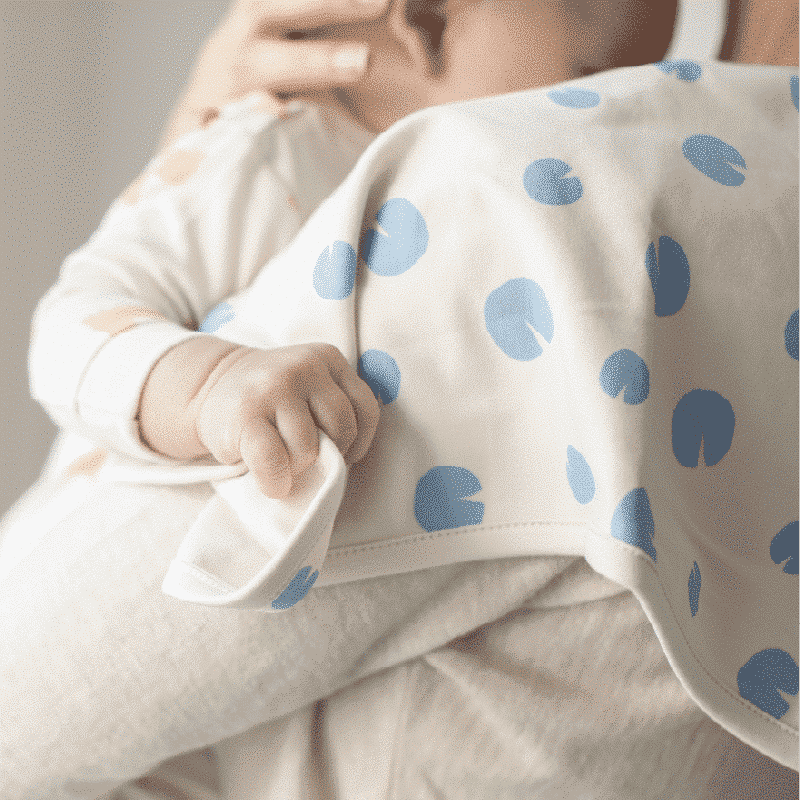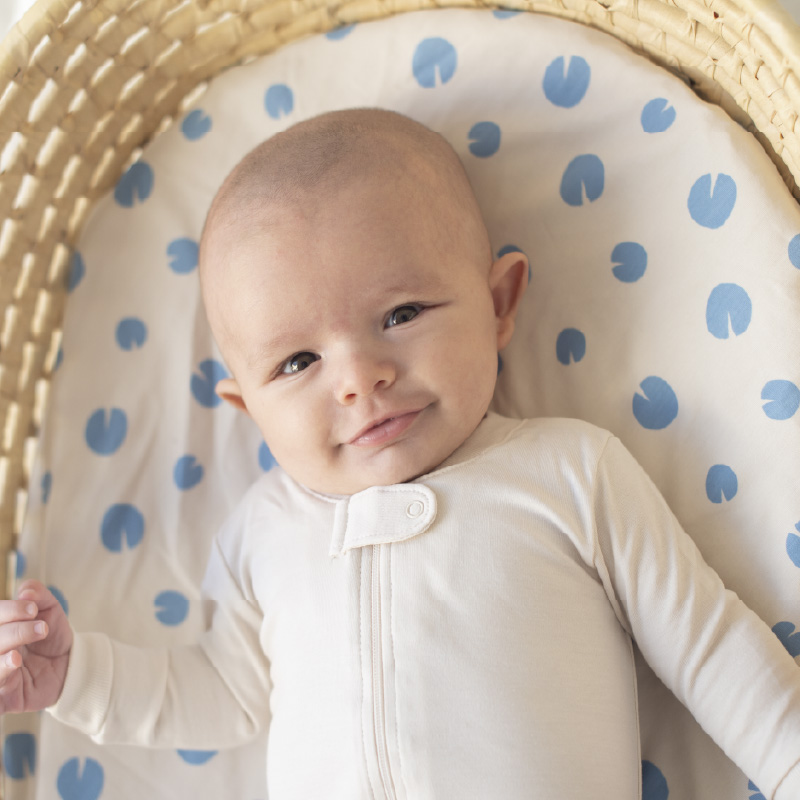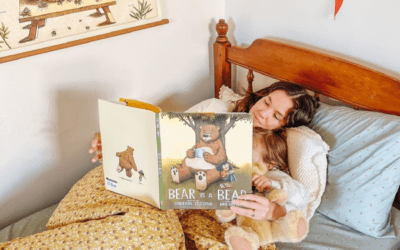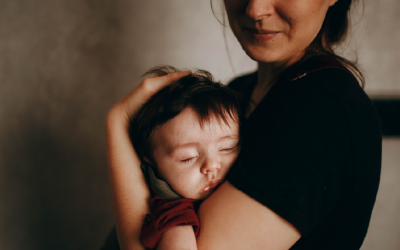Parents actually have more influence on their baby’s sleep habits than you might think. Here’s how to make sure that your influence is a positive one and you’re not creating habits that will affect your baby’s sleep quality.
Your Rockin’ Blinks Crib Sheet:
- Beginning around four months of age, the natural progression of sleep during the night involves multiple night wakings. These wakings are not only normal, they actually continue through adulthood.
- When your baby wakes at night, they should generally be able to get himself back to sleep without parental involvement.
- The main reason so many infants continue to wake during the night — and stay awake — is because of habits created by their parents when they are being put down to sleep for the night.
- If your baby falls asleep eating, being held, being driven around, or receiving help in some other way, they will need that sleep association to be repeated throughout the night each time he naturally wakes.
- Helping your baby develop positive sleep habits will enable them to self-soothe when they wake, and fall back asleep on their own.
Think your baby is too little (and cute) to have to have any bad sleep habits? We do too! In fact, your baby doesn’t really have any sleep habits at all — but you do! And you might be unwittingly sharing them with your little one when you put them to sleep at night.
While newborns don’t pick up much on parental behaviors relating to sleep, by the time your baby is about 4 months old, they’re much more impressionable. The good news is that it’s easy to help your baby develop better and healthy sleep habits for happy babies – it usually just takes a little patience and understanding. Here’s a few good habits and better habits to help you set a positive example, and lay a healthy sleep foundation for your baby.
Good and Better baby sleep habits
-
Good Habit: Acknowledge that night wakings are normal
Better Habit: Understand why these wakings occur so you reduce your stress during this time.
At around 4 months, your baby’s natural progression of sleep during the night might involve multiple night wakings — not because they’re hungry, the way a newborn might wake, but simply because that’s the way sleep works even into adulthood. We go from light sleep, to deep sleep, to dream sleep, then wake briefly before repeating the cycle. While most babies will sleep for long night sleep periods by six months, about a third continue to wake.[7] Some will settle into a pattern of fewer night wakings, only to revert to waking more often again. Others don’t seem to ever get into longer night sleep, with a few continuing to struggle well into middle childhood.[8]
-
Good Habit: Introduce associations that help your baby get to sleep.
Better Habit: Make sure these sleep associations are things that will remain constant throughout the night so they can fall back to sleep when they wake.
While there are many factors that affect sleep, the primary reason so many infants continue to wake during the night is due to “problematic sleep onset associations” that we introduce when they are initially going to sleep. What makes these sleep associations “problematic” is that while it was available to your baby when they fell asleep at bedtime, it may no longer be present once your baby wakes during the night.[9] A baby who falls asleep being held, being driven around, or receiving help in some other way that the baby cannot do independently, will want that sleep association to be repeated throughout the night when coming to one of these natural waking points. Instead, choose positive sleep associations that can remain constant throughout the night, such as white noise, the coziness of the crib or bassinet, and thumb-sucking. These will help your baby get back to sleep easily when they wake.
-
Good Habit: Use feeding as part of your bedtime routine.
Better Habit: Switch the order of your bedtime routine so feeding is not the last thing your baby does as they drift off.
Babies are born pattern-seekers. While it is natural for a newborn to fall asleep while feeding, it can become a habitual association that baby requires in order to sleep. To loosen this connection, provide just a little bit of separation between feeding and sleep. At first this might mean just watching your baby as he or she starts to drift off, and pulling the baby off of the breast or removing the bottle before the baby is fully asleep. If your baby becomes distressed, you can continue holding or rocking for soothing.
-
Good Habit: Feed your baby during the night if they still need it.
Better Habit: Pause before responding to a night waking with feeding. They may not actually be hungry.
Studies show non-feeding soothing strategies work. One experiment had parents gradually increase the time between their baby’s feedings at night by offering different soothing strategies other than feeding when the baby woke at night. By eight weeks of age, all of these babies were sleeping uninterrupted from at least midnight to 5am.[17] In another study, researchers tracked infants’ longest stretches of sleep and how quickly parents responded to the infant waking at night. Among bedsharing infants, who typically were fed immediately when they woke, 37% were sleeping for at least a 5-hour period by the time they were three months old. In contrast, among infants whose parents consistently paused for just one minute before responding to a night waking, 89% were sleeping for at least five hours at three months of age.[18]
-
Good Habit: Practice putting down your baby awake at bedtime.
Better Habit: Make this part of the baby’s regular bedtime routine by 10-12 weeks.
Babies who are able to fall asleep on their own at bedtime are significantly more likely to resettle on their own when they wake at night.[19] “Self-soothing” refers to a baby’s ability to transition from awake to asleep at bedtime and between normal waking points during the night.[20] Infants typically develop this skill between ten to twelve weeks of age,[21] so this is a good point to begin offering opportunities for your baby to be placed in the crib or bassinet awake at bedtime. With practice babies learn to associate the crib as the place where they fall asleep.
-
Good Habit: Try to adjust your baby’s light exposure to the natural rhythm of the day.
Better Habit: Seek out daylight during the day and make your baby’s room pitch black at night.
Life originated under conditions of distinctly separated light and dark cycles, but modern life has drifted greatly from that rhythm. Abundant evidence suggests, even from our earliest days of life, that we benefit from being outside as much as possible during the day and minimizing artificial light at night. Indoor lighting is far dimmer during the day than sunlight; it’s also much brighter at night than moonlight would ever be. Babies who were exposed to more bright light at six weeks of age slept for longer stretches of time at twelve weeks of age, as compared to babies with lower levels of daytime light.[11] Even in premature infants, cycled lighting (as opposed to constant low-level lighting) results in clear patterns of sleep and activity.[12] Since the light/dark cycle is the strongest influence on a baby’s developing circadian rhythm, paying attention to your baby’s environment is a powerful way to improve sleep.
-
Good Habit: Keep your baby’s bedtime consistent every day.
Better Habit: Make that bedtime early, ideally before 7 or 8pm.
Since the rising and setting of the sun happen at consistent times from one day to the next, humans also benefit from regular sleep and rise times. One study found that early (before 9pm) and consistent lights out timing was associated with more night time sleep in one-month old infants. In homes where there was not an early lights out time, still having a consistent time resulted in those infants sleeping more at night than when the timing was inconsistent.[13] In another study, six-week old infants who had a consistent bedtime between 7-8pm slept more at night than those with later bedtimes, with no difference in daytime napping as a result of more sleep at night.[14]
-
Good Habit: Keep your baby’s awake times short during the day.
Better Habit: Look for sleep signs and respond quickly with a nap.
Since sleep pressure rises so quickly in newborns, they can only stay awake for very short periods of time without becoming overtired. During your baby’s first few weeks of life, 45 minutes awake might be all that your baby can tolerate. By two months of age, a rhythm develops of 90 minutes of alertness between daytime naps.[15] After 4 months of age, your baby will feel more comfortable staying awake for longer periods, between 2-3 hours in between naps and before bedtime.
-
Good Habit: Develop a bedtime routine.
Better Habit: Include pleasurable activities in that routine to signify to your baby that bedtime is a great time!
Sleep is an involuntary activity. To allow sleep to happen more automatically, create a consistent bedtime routine. This creates predictability for your infant, builds trust, and signals that bedtime is a pleasant thing. Having a simple bedtime routine, such as a final feeding, offering a bath or a wipe-down with a warm washcloth, and a brief massage, results in little ones having an easier time falling asleep, waking less often, waking for shorter periods at night, and sleeping for longer at night.[16]
Good sleep is essential for a happy healthy childhood and life. Book a consultation with us now!
References
[7] Weinraub, M., Bender, R. H., Friedman, S. L., Susman, E. J., Knoke, B., Bradley, R., … Williams, J. (2012). Patterns of developmental change in infants’ nighttime sleep awakenings from 6 through 36 months of age. Developmental Psychology, Vol. 48, pp. 1511–1528. https://doi.org/10.1037/a0027680
[8] Williamson, A. A., Mindell, J. A., Hiscock, H., & Quach, J. (2019). Sleep Problem Trajectories and Cumulative Socio-Ecological Risks: Birth to School-Age. Journal of Pediatrics, 215, 229-237.e4. https://doi.org/10.1016/j.jpeds.2019.07.055
[9] Meltzer, L. J. (2010). Clinical Management of Behavioral Insomnia of Childhood: Treatment of Bedtime Problems and Night Wakings in Young Children. Behavioral Sleep Medicine, 8(3), 172–189. https://doi.org/10.1080/15402002.2010.487464
[10] Grigg-Damberger, M., Gozal, D., Marcus, C. L., Quan, S. F., Rosen, C. L., Chervin, R. D., … Iber, C. (2007). The visual scoring of sleep and arousal in infants and children. Journal of Clinical Sleep Medicine : JCSM : Official Publication of the American Academy of Sleep Medicine, 3(MARCH 2007), 201–240. Retrieved from http://www.ncbi.nlm.nih.gov/pubmed/17557427
[11] Harrison, Y. (2004). The relationship between daytime exposure to light and night-time sleep in 6-12-week-old infants. Journal of Sleep Research, 13(4), 345–352. https://doi.org/10.1111/j.1365-2869.2004.00435.x
[12] Rivkees, S. A. (2003). Developing Circadian Rhythmicity in Infants. Pediatrics, 112(2), 373 LP – 381. Retrieved from http://pediatrics.aappublications.org/content/112/2/373.abstract
[13] Iwata, S., Fujita, F., Kinoshita, M., Unno, M., Horinouchi, T., Morokuma, S., & Iwata, O. (2017). Dependence of nighttime sleep duration in one-month-old infants on alterations in natural and artificial photoperiod. Scientific Reports, 7. https://doi.org/10.1038/srep44749
[14] Adams, E., Savage, J., Master, L., & Buxton, O. (2020). Time for bed! Earlier sleep onset is associated with longer nighttime sleep duration during infancy. Sleep Medicine, 73, 238–245. https://doi.org/10.1016/j.sleep.2020.07.003
[15] McGraw, K., Hoffmann, R., Harker, C., & Herman, J. H. (1999). The development of circadian rhythms in a human infant. Sleep, 22(3), 303–310. Retrieved from http://www.ncbi.nlm.nih.gov/pubmed/10341380
[16] Mindell, J. A., Li, A. M., Sadeh, A., Kwon, R., & Goh, D. Y. T. (2015). Bedtime routines for young children: a dose-dependent association with sleep outcomes. Sleep, 38(5), 717–722. https://doi.org/10.5665/sleep.4662
[17] Pinilla, T., & Birch, L. L. (1993). Help Me Make It Through the Night: Behavioral Entrainment Breast-Fed Infants’ Sleep Patterns. Pediatrics, 91(2), 436–444. Retrieved from http://pediatrics.aappublications.org/content/91/2/436
[18] St. James-Roberts, I., Roberts, M., Hovish, K., Owen, C., & James-Roberts, I. S. (2015). Video Evidence That London Infants Can Resettle Themselves Back to Sleep After Waking in the Night, as well as Sleep for Long Periods, by 3 Months of Age. Journal of Developmental and Behavioral Pediatrics : JDBP, 36(5), 324–329. https://doi.org/10.1097/DBP.0000000000000166
[19] Mindell, J. A., Sadeh, A., Kohyama, J., & How, T. H. (2010). Parental behaviors and sleep outcomes in infants and toddlers: a cross-cultural comparison. Sleep Medicine, 11(4), 393–399. https://doi.org/10.1016/j.sleep.2009.11.011
[20] Anders, T. F., & Keener, M. (1985). Developmental course of nighttime sleep-wake patterns in full-term and premature infants during the first year of life. I. Sleep, 8(3), 173–192. Retrieved from http://www.ncbi.nlm.nih.gov/pubmed/4048734
[21] Mindell, J. A., & Owens, J. A. (2015). A clinical guide to pediatric sleep : diagnosis and management of sleep problems (3rd ed.).
Subscribe to our Newsletter and get the latest in sales, sleep information and more











